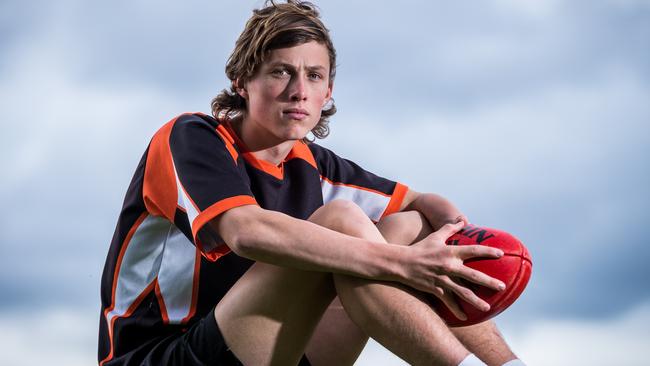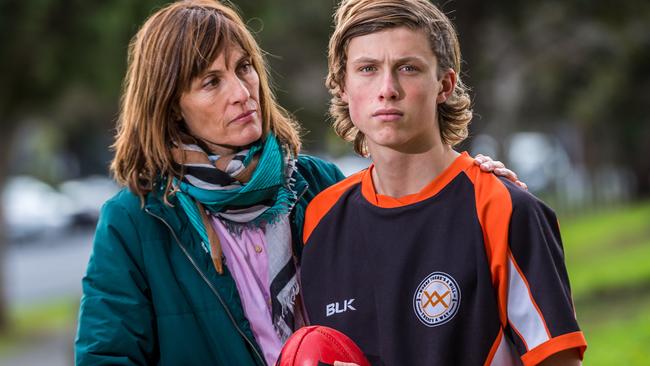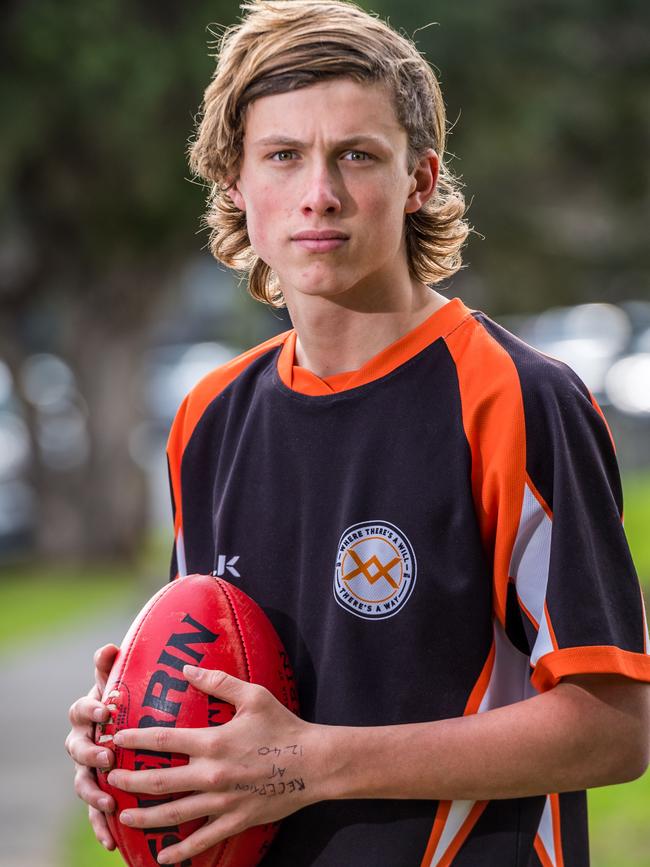Concussions in junior sport triple among grassroots Aussie rules footballers
Teen footballers are copping a bruising, with a shocking increase in concussions at grassroots clubs. The results paint a terrifying picture about head injuries — and they’re only the tip of the iceberg.

VIC News
Don't miss out on the headlines from VIC News. Followed categories will be added to My News.
Concussion among junior footballers has increased threefold in recent years, a new study has found.
The landmark research has revealed a spike in grassroots Aussie rules injuries sidelining young players for a week or more, with the biggest increase in cases of concussion.
The study of footballers aged 15 to 17 found cases of concussion rose from 0.5 to 1.5 per club each season on average between 2009-11 and 2015-2017.
It comes as a specialist concussion unit at the Murdoch Children’s Research Institute revealed up to 30 kids a week were typically admitted during the football season — twice as many as at other times.
Research author Dr Samuel Chalmers compared injury data from 2009-11 seasons with findings from 2015-17 and said the rise in concussions was “potentially due to two reasons’’.
“We’ve probably seen an increase in professionalism over that time, which filters down to junior players and probably makes the game faster,’’ he said.
“This can potentially result in heavier collisions. That can be a factor. The other thing could be that clubs are more conservative with their management, so players may be rested if they are showing signs of concussion.’’

The research — presented at a World Congress on Science and Football hosted by Melbourne’s Victoria University — studied junior footballers over an 18-match season.
Academics said the numbers of concussions recorded were probably the tip of the iceberg, because the study did not include injuries from training sessions, pre-season games or finals. The number of concussions was likely to be even higher because many junior players did not seek medical treatment.
Academics and medical experts yesterday hailed the new research as groundbreaking because it measured raw incidents of concussion at the source, instead of relying on hospital admission data.
Murdoch Children’s Research Institute director of clinical sciences research Vicky Anderson said the findings were “particularly interesting”.
“They’re getting the kids on the sidelines … it gives the real instances of concussion,’’ she said.
Dr Anderson, president of the International Neuropsychological Society, said 25 per cent of kids who visited the clinic had ongoing symptoms such as headache, fatigue, balance problems and depression or anxiety.

She said the new research was “extra compelling” because it focused on teenagers suffering concussion at the “most disruptive’’ time, as they entered the finals years of high school.
“From our understanding, there is not a real policy from the Education Department to deal with these sort of injuries,’’ she said.
The Multi-year Injury Surveillance of Elite Junior Australian Football study measured injuries serious enough for players to miss at least one match.
Ankle sprains were the most common injury, followed by hamstring strains and concussion.
The research of under-18 players found there were 21 new injuries reported per club in the 2015-17 data — a rise of almost three injuries compared to the 2009-11 season.
La Trobe University Associate Professor Alan Pearce said the new research proved there was more awareness now about the severity of concussion.
“From my own experience, people in the field are now more attentive to any sort of injury to the head,’’ he said.

TEEN STAR’S HEAD KNOCK ULTIMATUM
When junior footy star Elliott Perkins suffered his third concussion in a single season, his mum knew the family had a serious decision to make.
A “scary’’ concussion in a club game saw the Melbourne teenager stretchered from the field, drifting in and out of consciousness and feeling the effects of a head injury that would be long-lasting.
When he suffered two more concussions from head knocks in school and club games, Victoria Perkins gave her footy-loving son an ultimatum.
He could stay away from football until the condition cleared or give away the game if he got another head injury.
“It’s hard when you’ve got boys who love their football and don’t really take seriously or have any idea of the long-term consequences of concussion,’’ she said.

“Back then, and probably even now, there wasn’t a firm process the club or the coaches had in place when you had to deal with a concussion.’’
Mrs Perkins welcomed new research into concussion today, revealed by the Herald Sun, stressing families had to take any head injury affecting a junior player seriously.
“The advice I got was it’s worse in children because their brain is still developing,’’ she said.

“As parents, you think about the future more than children — most kids probably think of the moment and if they’re feeling OK at the time say, ‘why can’t I go out and play with my mates?’’’
Elliott, 15, had two concussions playing for East Sandringham in the South Metro Junior Football League and another playing for his school, Brighton Grammar. Only once did he go to hospital.
Elliott said he was surprised by the rise in concussion rates.
“It’s obviously a pretty scary thing,’’ he said. “I’ve been OK since and haven’t really had any head knocks but I still get a few headaches which I’m trying to get to the bottom of.
“I love footy and didn’t want to give that up but my mum didn’t really want me to continue playing because it was too much of a risk.’’
MORE: ‘UNFORGIVABLE’: BOMBERS’ GOAL LINE BLOOPER
FORMER AFL STAR SLAMS ‘BALD-HEADED FLOG’ UMPIRE
Mrs Perkins said her son was lucky to keep playing and more needed to be done to educate families.
“He didn’t like not being part of the team; boys love footy and they don’t want to miss out,’’ she said.
“But he was off school and slept for most of three days after the most significant concussion and had bad headaches which weren’t good.’’
One in 20 children suffers concussion by the age of 16. The Murdoch Children’s Research Institute created the HeadCheck app to help parents recognise concussion and manage their child’s recovery.



